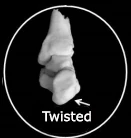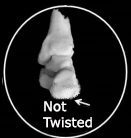
The PreClinical Clubfoot Deformity is Almost 4 Million Years Old
I had the good fortune of communicating with two anthropologists; Jeremy DeSilva at Boston University and Bernard Zipfel at the Univeristy of Witwaterstrand, Johannesburg, South Africa; who excitedly recounted their recent discoveries - fossilized bones of Australopithecus Sediba, the prototype (ancestor) of homo sapiens - that dated back almost two million years ago.
While investigating the foot fossils of A.Sebida's feet, they found a torsio (twist) in the both the heel bone (See Photo Posterior Aspect of Calcaneus) and talus (the bone on top of the heel bone).

Photo of Posterior Aspect of Heel Bone in Supinatus - part of the fossil foot bones of A.Sebida
Photo courtesy of Jeremy M. DeSilva - reproduced from The Lower Limb and Mechanics of Walking in Australopithecus sediba. Research Articles, August 2, 2013.
Why was this information significant?
Though the anthropologists made no connection between the torsion (supinatus) in the heel bone and talar bones of our ancestors and the way that they walked, their discoveries confirmed/validated what I had already discovered and written about many years ago - the foot structure I termed 'PreClinical Clubfoot Deformity'.
The PreClinical Clubfoot Deformity is defined as a foot structure where both the posterior aspect of the calcaneus and talar head are in supinatus - the same torsion (supinatus) found in the fossilized foot bones of A.sebida.
Also, the fossilized foot prints are exactly the same foot prints that you can see today - three million years later - in a person who has a PreClinical Clubfoot Deformity.

Why is the PreClinical Clubfoot Deformity - a 4 Million Year Old Foot - Still Around Today?
Our ancestors evolved from being tree dwellers that occasionally walked on the ground on all four legs, to two legged walkers living predominately on the ground. The PreClinical Clubfoot Deformity was the change in the foot structure that allowed them to walk on two feet. All our ancestors had a PreClinical Clubfoot structure - then it was a normal foot structure. And at that time it served their purpose as it made them more efficient hunters.
Over the next two millions years, as our ancestors became more and more solely two-legged walkers (living more and more on the savanna and less in the trees) the foot continued its' evolution making it easier and easier to walk on two feet. Hence, over time, the PreClinical Clubfoot structure started evolving into the Primus Metatarsus Supinatus foot structure (aka Rothbarts Foot) and then the Plantargrade foot structure in which the posterior aspect of the calcaneus and talar head completed their ontogenetic torsional development (See Photo Below - Posterior Aspect of Plantargrade Calcaneus).

Photo of the posterior aspect of a Plantargrade calcaneus
Above photo shows the posterior aspect of the calcaneus in a Plantargrade Foot Structure
Ontogeny Recapitulates Phylogeny
More specifically, the human foot is in the process of evolving from what was predominantly a PreClinical Clubfoot structure (in which the posterior aspect of the calcaneus and talar head have a structural inward/supinatus twist) towards a Plantargrade Structure Foot (in which the calcaneus and talus no longer retain their inward twist). The Rothbarts Foot (in which just the talar head has a structural inward twist/supinatus) represents an intermediate stage in this evolutionary process.
This had been a slow evolutionary process over millions of years and will probably take another few million years for everyone's foot to become a Plantargrade Foot Structure.
Currently, the Rothbarts Foot and PreClinical Clubfoot Deformity are present in about 80% of the world population. A few million years from now, it will be difficult to find an individual with either one of these two foot structures.
My hypothesis to explain this:
The PreClinical Clubfoot Deformity - which may have served us well million of years ago - is no longer useful or helpful, as evidenced by the pandemic of chronic muscle and joint pain that we see in people who have this foot structure today.
Professor Brian A Rothbart
Director of Research, International Academy of RPT
References
Bates KT, Collins D, Savage R., et al. 2013. The evolution of compliance in the human lateral mid-foot. Proceedings Royal Society Biological Sciences, 280, 20131818. Published 21 August 2013
Crompton RH, Pataky TC, Savage R., et al 2011. Human-like external function of the foot and fully upright gait, confirmed in the 3.66 million year old Laetoli hominin footprints by topographic statistics, experimental footprint-formation and computer stimulation. Hournal of Royal Society Interface 9, doi: 10.1098/rsif.2011.0258, Published online 20 July 2011.